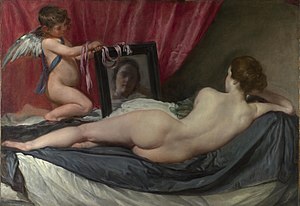Private Life of a Masterpiece Episode 4: Diego Velázquez - The Rokeby Venus (BBC Documentary)
The Rokeby Venus (also known as The Toilet of Venus, Venus at her Mirror, Venus and Cupid, or La Venus del espejo) is a painting by Diego Velázquez (1599--1660), the leading artist of the Spanish Golden Age. Completed between 1647 and 1651, and probably painted during the artist's visit to Italy, the work depicts the goddess Venus in a sensual pose, lying on a bed and looking into a mirror held by the Roman god of physical love, her son Cupid. The painting is in the National Gallery, London.
| Rokeby Venus (La Venus del espejo), Diego Velázquez, 1644–1648, Oil on canvas, 122 × 177 cm, National Gallery, London (Photo credit: Wikipedia) |
their direction. This phenomenon is known as the Venus effect. In a number of ways the painting represents a pictorial departure, through its central use of a mirror, and because it shows the body of Venus turned away from the observer of the painting.
The Rokeby Venus is the only surviving female nude by Velázquez. Nudes were extremely rare in seventeenth-century Spanish art, which was policed actively by members of the Spanish Inquisition. Despite this, nudes by foreign artists were keenly collected by the court circle, and this painting was hung in the houses of Spanish courtiers until 1813, when it was brought to England to hang in Rokeby Park, Yorkshire. In 1906, the painting was purchased by National Art Collections Fund for the National Gallery, London. Although it was attacked and badly damaged in 1914 by the suffragette Mary Richardson, it soon was fully restored and returned to display.
-Wikipedia

